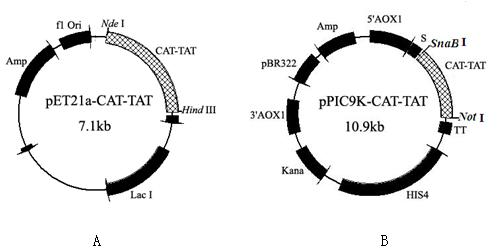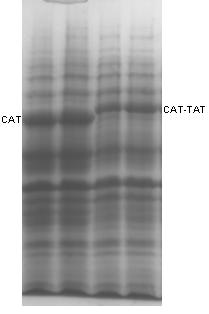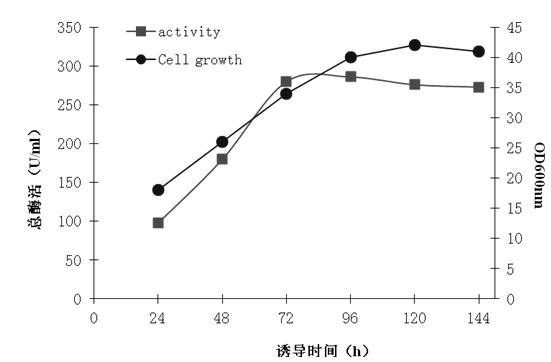Gene for coding catalase as well as preparation method and application thereof
A catalase and gene technology, applied in the field of gene encoding catalase and its preparation, can solve the problems of difficult to penetrate cell membrane, difficult application, large molecular weight of natural enzyme, etc., and achieves the improvement of catalase activity. Effect
- Summary
- Abstract
- Description
- Claims
- Application Information
AI Technical Summary
Problems solved by technology
Method used
Image
Examples
Embodiment 1
[0040] Example 1 Cloning of CAT and CAT-TAT genes
[0041] (1) Isolation and extraction of total RNA:
[0042] (2) Synthesis of the first strand of cDNA:
[0043] Reverse transcription into the first-strand cDNA: refer to the product description of (First-straind cDNA Synthesis KIT), in a 20ul system, add 1ug total RNA, 1ul Oligo dT18 (500ug / ml) and Rnase-free water, at 70℃ water bath temperature After incubating for 10 minutes, immediately place it in an ice bath to cool; continue to add 4ul 5×Buffer, 2ul 0.1M DTT and 1ul 10mM dNTPs to the cooled tube, mix well and keep in a 42℃ water bath for 2min; add 1ul (200U) Keep the reverse transcriptase at 42°C for 50 minutes; finally, place it in a water bath at 70°C for 15 minutes to inactivate the reverse transcriptase to obtain the first strand cDNA. Set up a negative control without RNA during the experiment.
[0044] (3) Get the target gene by PCR
[0045] Design primers based on the human CAT gene sequence published by NCBI: P1 (SEQ ...
Embodiment 2
[0054] Example 2 Expression of CAT-TAT encoding gene in E. coli
[0055] The plasmid pMD-18T-CAT-TAT1 obtained in Example 1-(4) was passed through Nde I and Hind Ⅲ Double enzyme digestion to obtain CAT-TAT fragment, and after Nde I and Hind Ⅲ Connect the double digested pET21a(+) plasmid, transfer the linker into the prepared competent cell DH5ɑ, screen for blue and white spots, and extract the plasmid for identification (the method is the same as in Example 1), to obtain the recombinant plasmid pET21a(+)- CAT-TAT (such as figure 1 Shown in A).
[0056] Take 1ul of the constructed recombinant plasmid pET21a(+)-CAT-TAT, add it to 100ul of prepared competent cells (E. coli Rosetta2(DE3)), spread on LB plate (containing 100ug / ml ampicillin), culture at 37℃ Incubate overnight, pick the positive clones that grow on the resistant plate and insert them into 2ml LB medium (containing 100ug / ml ampicillin), cultivate overnight at 37℃ and 250rpm with shaking, and transfer to 50ml LB cultu...
Embodiment 3
[0057] Example 3 Construction of yeast recombinant expression vector of CAT-TAT encoding gene
[0058] The plasmid pMD-18T-CAT-TAT2 obtained in Example 1-(4) was used SnaB I and Not I Carry out restriction digestion. The digested sample is tested by nucleic acid electrophoresis and the target gene is recovered with a gel recovery kit (Shanghai Shenggong). And Jing SnaB I and Not I double digested pPIC9k plasmid was ligated with T4 ligase in a 16°C water bath for 3 hours, and the ligation was transferred to DH5α (the method is the same as in Example 1). Pick the resistant strains and cultivate, and extract the plasmids. SnaB I and Not I Carry out restriction digestion and nucleic acid electrophoresis detection to obtain the recombinant plasmid pPIC9k-CAT-TAT (such as figure 1 Shown in B).
[0059] Using the obtained pPIC9k-CAT-TAT recombinant plasmid as a template, PCR amplification was performed with CAT-TAT specific primers P3 and P4, and the amplification procedure was...
PUM
 Login to View More
Login to View More Abstract
Description
Claims
Application Information
 Login to View More
Login to View More - R&D
- Intellectual Property
- Life Sciences
- Materials
- Tech Scout
- Unparalleled Data Quality
- Higher Quality Content
- 60% Fewer Hallucinations
Browse by: Latest US Patents, China's latest patents, Technical Efficacy Thesaurus, Application Domain, Technology Topic, Popular Technical Reports.
© 2025 PatSnap. All rights reserved.Legal|Privacy policy|Modern Slavery Act Transparency Statement|Sitemap|About US| Contact US: help@patsnap.com



